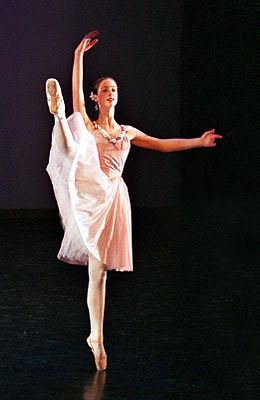Ballerina Megan Maher dances en pointe to Valse Fantasie during Scarsdale Ballet's Spring, 2010 Concert Dance performance at SUNY Purchase, NY (© Michael Maher).

The Photo:
Photographing stage performances by your kids can be very difficult. The lighting is rarely adequate to capture the fast-moving activity on stage, and your child is moving around so much it’s tough to keep him/her in focus. My daughter is a ballet dancer, and less than half of her performance numbers have enough light for me to capture good photos. The approach that works best in such situations is twofold – 1) photograph the ones you can when there is ample light, and 2) for those without enough light, use a slow shutter speed and shoot when there is not very much motion. It’s also smart to plan your pictures in advance, asking your kid beforehand where he/she will be entering, standing, moving and exiting the stage, so it’s easy to anticipate, focus and shoot. Take a few close-ups of your kid, and avoid shooting from far away, or you’ll be unable to clearly distinguish your kid from the others on stage. I was lucky with this photo, because I incorrectly set the shutter speed priority on my new digital camera, making every picture but this one blurry. Fortunately, all I needed was this one great shot.
3 Tips:
1) Stage performances are difficult to photograph because the lighting is often low, and the movement very fast.
2) Ask your kid about the performance so you know where he/she will be entering, standing, moving to, and exiting.
3) Be sure to take some close-ups of your kid and avoid taking crowd pictures of the stage from too far away.

